CIES Football Observatory Monthly Report
Issue no. 14 - April 2016
Spotting future stars
Drs Raffaele Poli, Loïc Ravenel and Roger Besson
1. Introduction
Playing numerous games during the first years of a professional career is an essential condition in order to be able to compete in the top level leagues worldwide. As a continuation of the analysis published in February 2015, this Monthly Report presents the experience capital approach developed by the CIES Football Observatory to identify players most likely to succeed in their career.
The paper first highlights the crucial role played by competitions outside of the big-5 leagues in the sporting development of footballers present in the latter championships. Indeed, only a small minority of footballers playing in the five major European competitions have never taken part in other leagues from the beginning of their adult career up until their 23rd birthday.
We go then on to explain the capital experience method and we highlight the average values measured for players of the big-5 leagues. Within this framework, we list the young footballers who are currently part of these championships with the highest values for experience. Finally, we review the most experienced U23 footballers among those currently playing in 26 other top division leagues of UEFA member associations.
2. The importance of playing
Current big-5 league footballers played on average 93.9 domestic league matches since the start of their professional career up until the semester preceding their 23rd birthday. The average number of matches played is 11.1 before 19 years of age, 26.8 before 20, 46.9 before 21, 69.7 before 22 and 93.9 before 23. B-team games are also included.
Generally speaking, forwards start their professional career earlier than footballers in other positions. They are thus likely to play a greater number of matches for each age threshold up until 23. At the other extreme, goalkeepers are fielded less during the first years of their career. Indeed, for this position, experience is more important than physical fitness. This also holds true, to a lesser extent, for defenders.
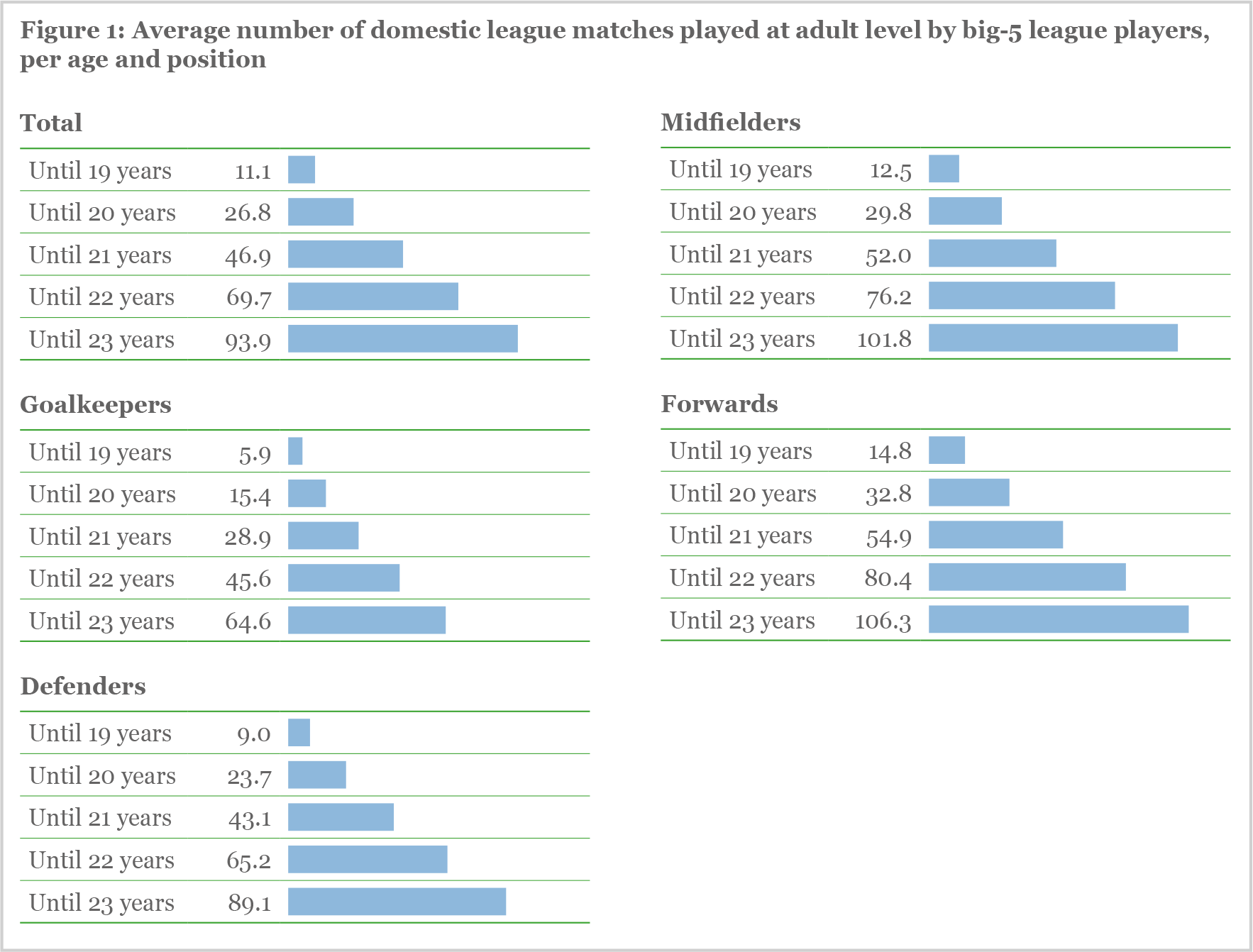
Among players aged 23 or over currently under contract with big-5 league clubs, only 5.4% have always played in teams taking part in these championships between the start of the professional career and the semester preceding their 23rd birthday. This percentage remains limited also by considering that footballers who played for B-teams of big-5 league clubs spent their entire career in the five major European championships: 16.6%.
The percentage of footballers having always played in the top leagues is particularly low among goalkeepers (3.3%). For other positions, this figure is between 5 and 6%. Even by including footballers who always played for big-5 league clubs but participated in B-team matches, the proportion of those who spent their entire career in the most competitive championships is low: between 11.6% for forwards and 18.7% for midfielders.
This analysis illustrates the crucial role of leagues outside the big-5 in the development of players’ careers. This holds true also for the most talented footballers. This finding suggests that the optimisation of the environment within which to promote talents goes hand in hand with partnerships and strategic alliances between teams of different levels.
Instead of recruiting a plethora of young talents who will never get their chance at the highest level, and in the interests of both the game and the players themselves, the wealthiest teams would do better to cooperate in a healthy and united manner with those of lesser means. This would permit the more regular fielding of talents since the very beginning of their adult career, which would give them the opportunity to fully develop their skills.
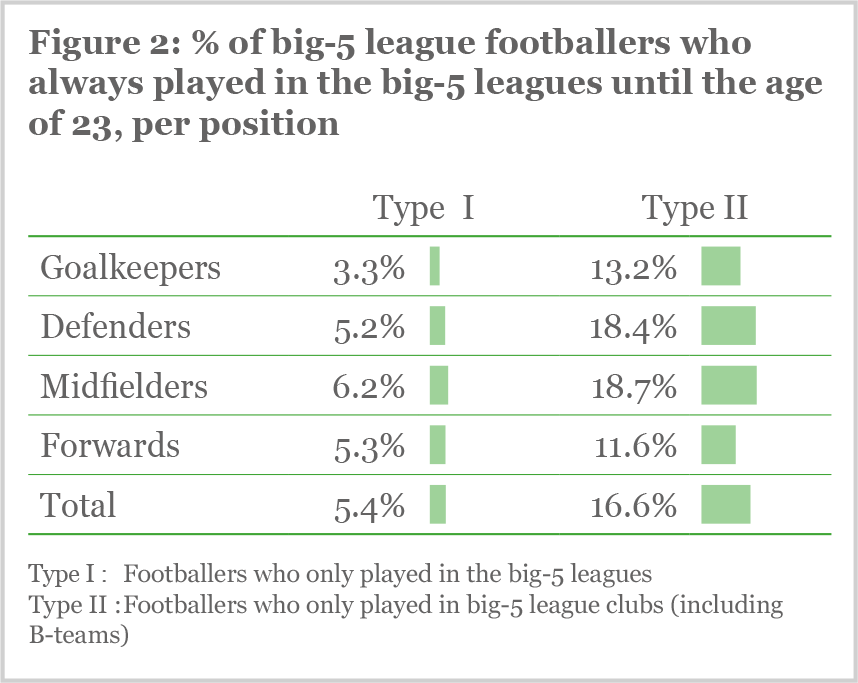
3. The experience capital method
The notion of experience capital refers to matches played in adult championships up until 23 years of age. This age is also taken into account by FIFA for the payment of training compensation when a first professional contract is signed.
To calculate experience capital, we attribute different values to matches according to an exclusive classification method that takes into account the performance of national association representatives in European club competitions, the division of the employer club in the domestic league and results achieved.
For extra-European countries, the value of matches was established according to correspondences made with European associations. For example, all other things being equal, a Brazilian top division match is equivalent to one in the top Portuguese league. This method allows us to compare the level of the experience gained by players on an international basis.
The analysis of the average experience capital of big-5 league players is also useful in establishing thresholds above which players from outside these championships have a concrete possibility of successfully joining the five major European competitions in the near future. This analysis indicates that in order to be able to cope with big-5 league demands, midfielders and forwards need to accumulate more experience capital from the outset of their career than defenders and goalkeepers.
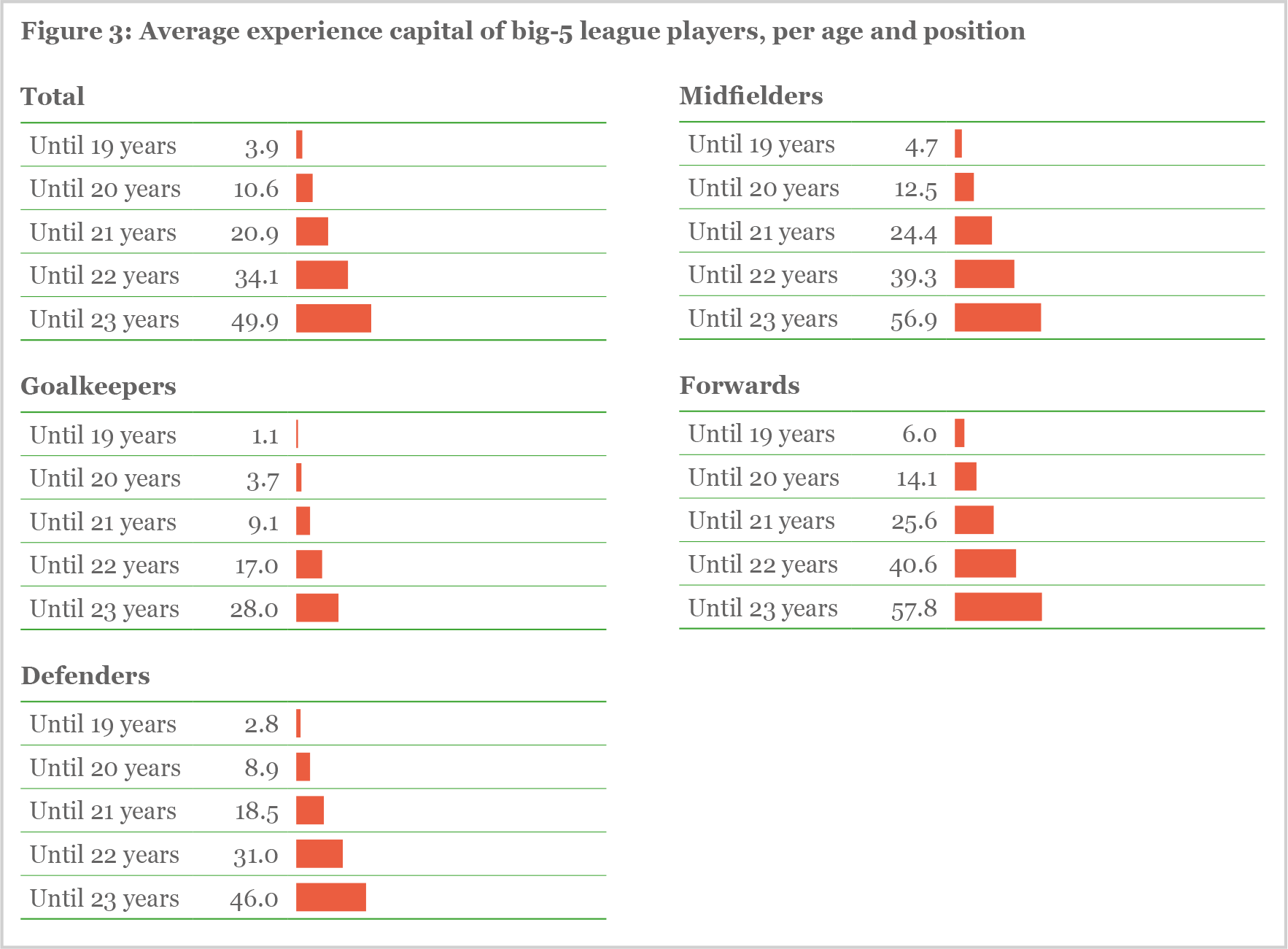
Hereafter, we present the five big-5 league players with the highest values for experience capital per position and year of birth. Among them are several players that are likely to leave their mark on the history of football. Despite their tender years, quite a number of them are already full internationals.
In the rankings for goalkeepers are notably two who were born in 1999: Gianluigi Donnarumma (Milan) and Alban Lafont (Toulouse). Our analysis also allows us to highlight goalkeepers whose experience capital is well above the average measured for all big-5 league goalkeepers at the same age: Mouez Hassan (Nice), Paul Nardi (Monaco), Pau López (Espanyol), Jan Oblak (Atlético Madrid), Timo Horn (Cologne), Alphonse Aréola (Villarreal, on loan from Paris St-Germain), Loris Karius (Mainz) and Jack Butland (Stoke).
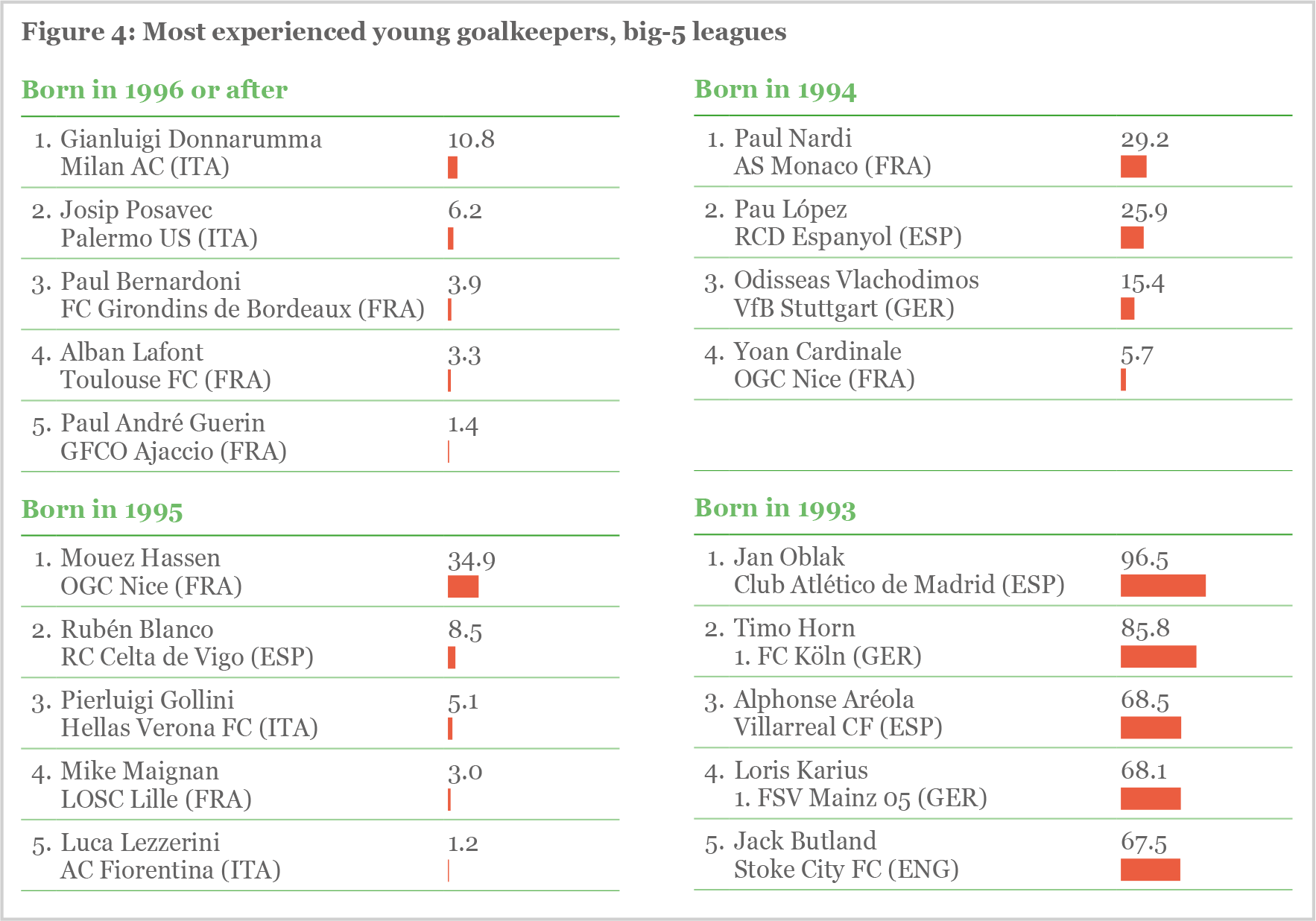
Precocious players are also numerous among centre backs. Three of the five most experienced central defenders according to year of birth are playing in Spain: Jorge Meré (Gijón), Aymeric Laporte (Bilbao) and Raphaël Varane (Real Madrid). The two other footballers heading the rankings are also on their way to pursuing a top flight career: Jonathan Tah (Bayer Leverkusen) and Alessio Romagnoli (Milan).
Among the most experienced young centre backs, similar to Raphaël Varane and Jonathan Tah, are several other players who have already played in national A-teams: Andreas Christensen (Danemark), José Giménez (Uruguay), Tin Jedvaj (Croatia), Patrick McNair (Northern Ireland), Marquinhos Aoás (Brazil), Kurt Zouma (France), John Stones (England), Karim Rekik (Netherlands), Matija Nastasić (Serbia), John Brooks (United States) and Antonio Rüdiger (Germany).
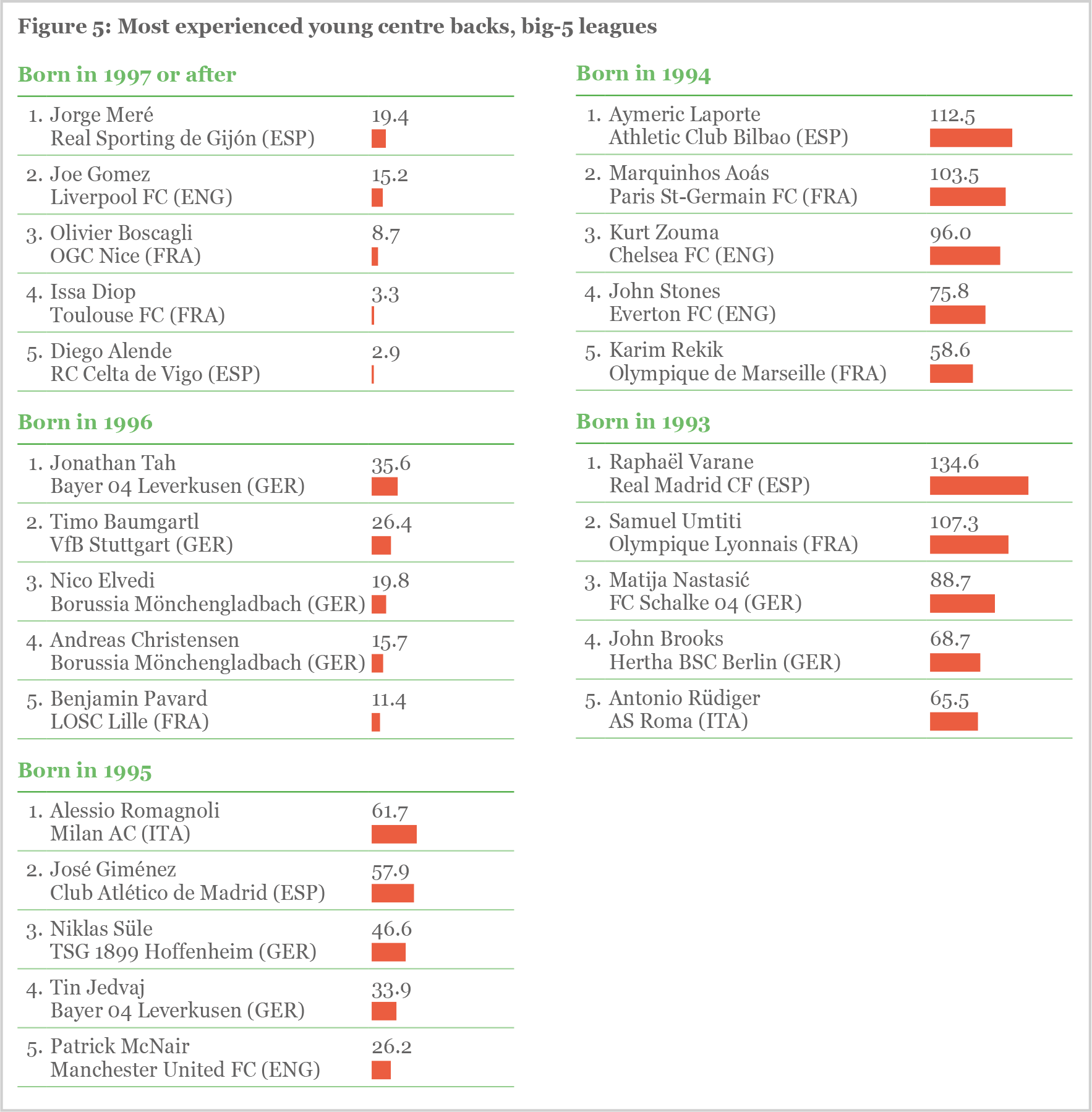
The five full backs at the top of the experience rankings play in clubs that are generally in the first half of the table in their respective league: Villareal (Adrián Marín), Everton (Brendan Galloway), Manchester United (Luke Shaw), Borussia Dortmund (Matthias Ginter) and Rome (Lucas Digne). However, with the exception of Adrián Marín, none of these players were trained in the youth academy of their employer club.
The greatest merit in the blossoming of these talents goes to Milton Keynes for Galloway, Southampton for Shaw, Freiburg for Ginter and Lille for Digne. Despite their young age, most of the players at the top of the experience rankings have been already the object of at least one transfer. This observation highlights the process of intensification of the mobility of the most promising players from a very early age (see Monthly Report n°13).
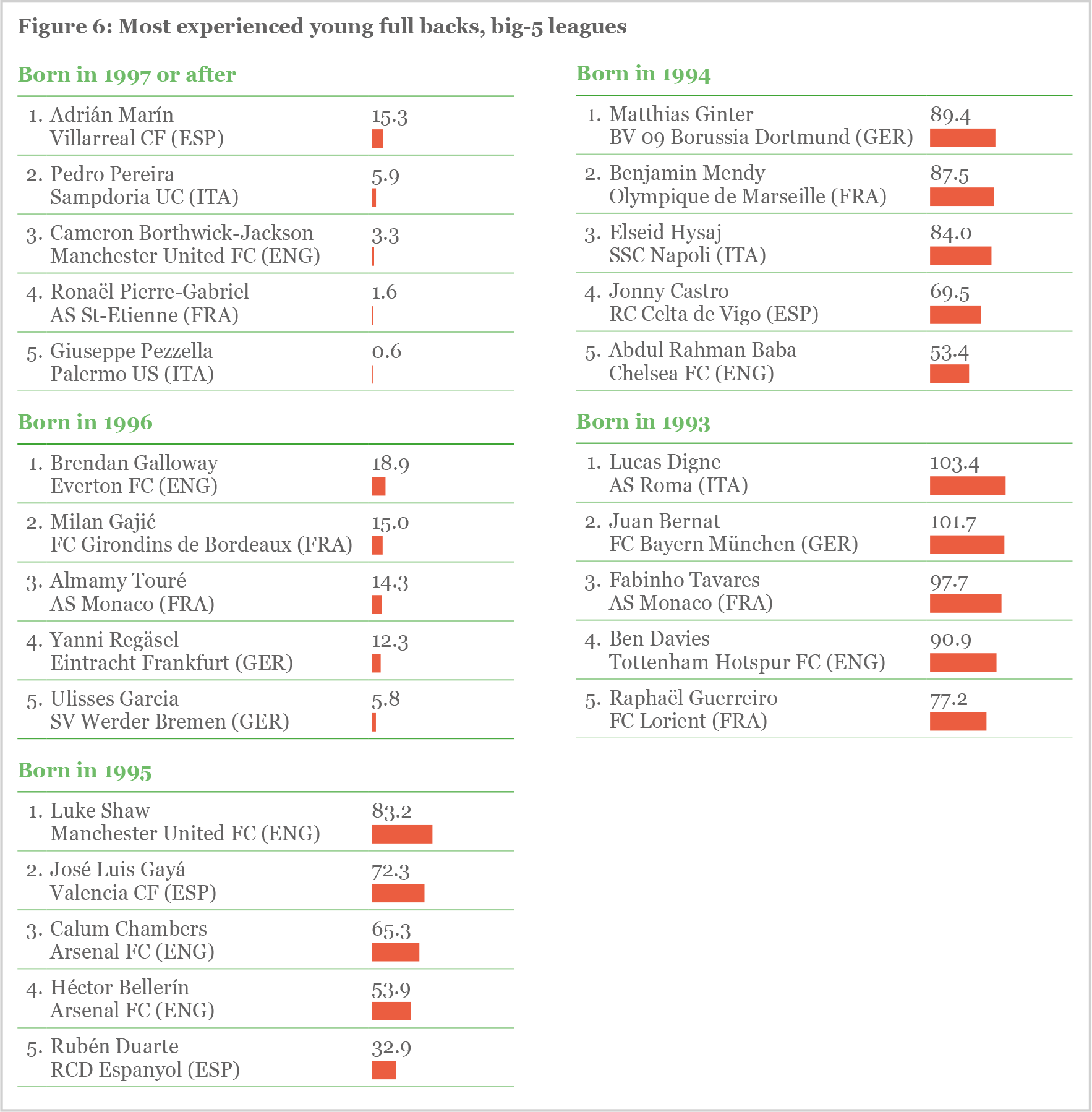
The list of big-5 league central midfielders with the most experience according to year of birth is impressive: Amadou Diawara, Danilo Barbosa, Adrien Rabiot, Mateo Kovačić and Paul Pogba. As their collegues ahead of them, players ranked in second position will also probably be future World Cup participants: Assane Dioussé (Senegal), Mahmoud Dahoud, Leon Goretzka and Emre Can (Germany), as well as Geoffrey Kondogbia (France).
None of the five central midfielders in the five top positions of the experience rankings playing in Serie A clubs is Italian: Amadou Diawara (Guinea), Assane Dioussé (Senegal), Godfred Donsah (Ghana), Paul Pogba (France) and Geoffrey Kondogbia (France). This observation confirms the reticence of clubs from the Peninsula to give young nationals their chance (see Monthly Report n°13).
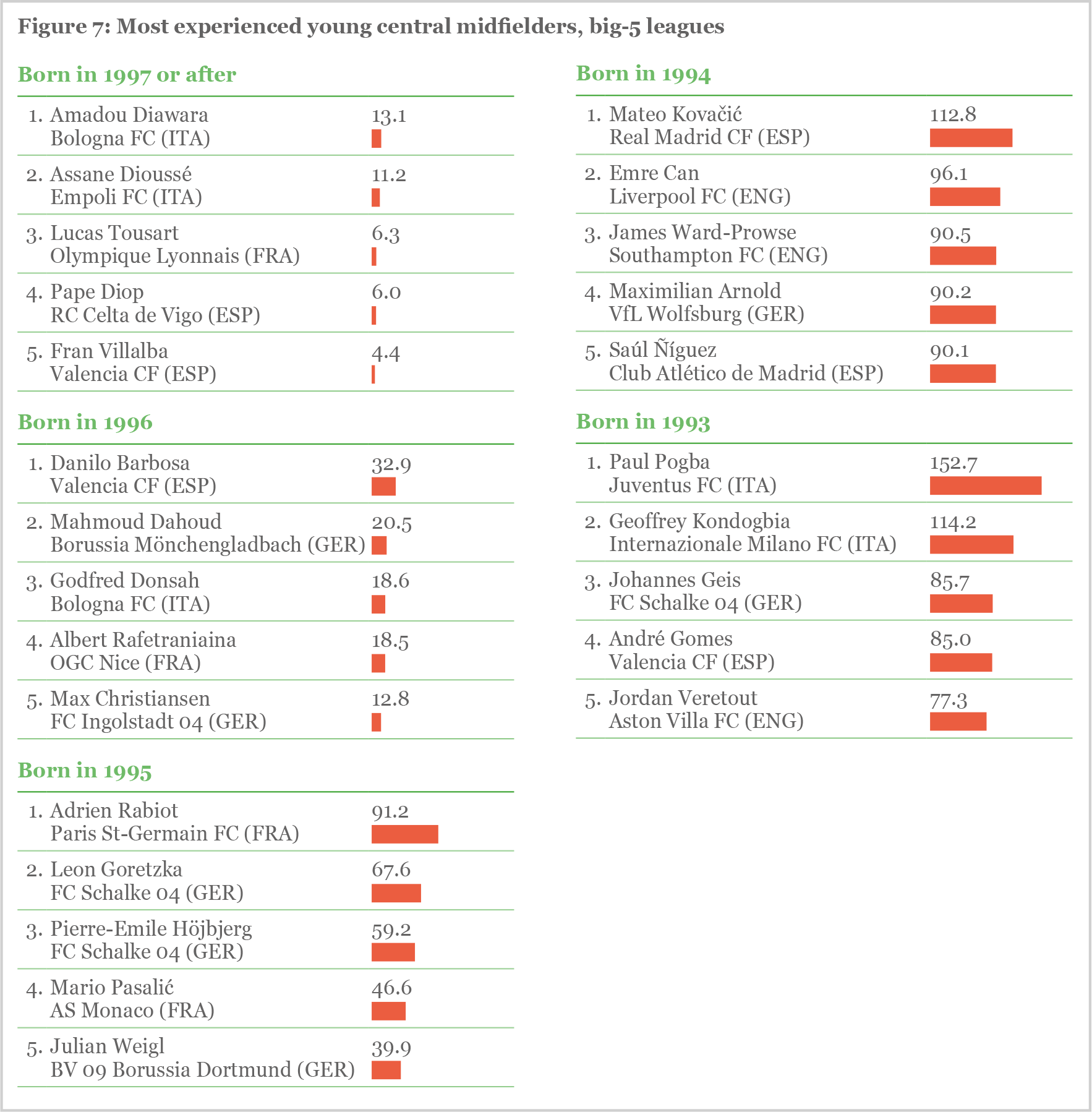
Players with five different nationalities head the rankings for attacking midfielders: France (Allan Saint-Maximin), Germany (Julian Brandt), Belgium (Adnan Januzaj), Spain (Gerard Deulofeu) and England (Alex Oxlade-Chamberlain). The young Tottenham and England prodigy Dele Alli is second among players born in 1996, just ahead of another extraordinary talent: the Croatian Alen Halilović (Gijón, on loan from Barcelona).
Like Halilović, other young players among the most experienced for their age group were loaned during the 2015/16 season or have already been loaned out in the past: Allan Saint-Maximin, Jérémie Boga, Jordon Ibe, Adnan Januzaj, Gerard Deulofeu, Moi Gómez, Rafinha Alcântara, Ross Barkley, as well as Florian Thauvin. For owner clubs, the recourse to loaning for young talents is a way to test their skills in teams with a lower level, with the hope that they will be able to acquire the experience necessary to have a successful career.
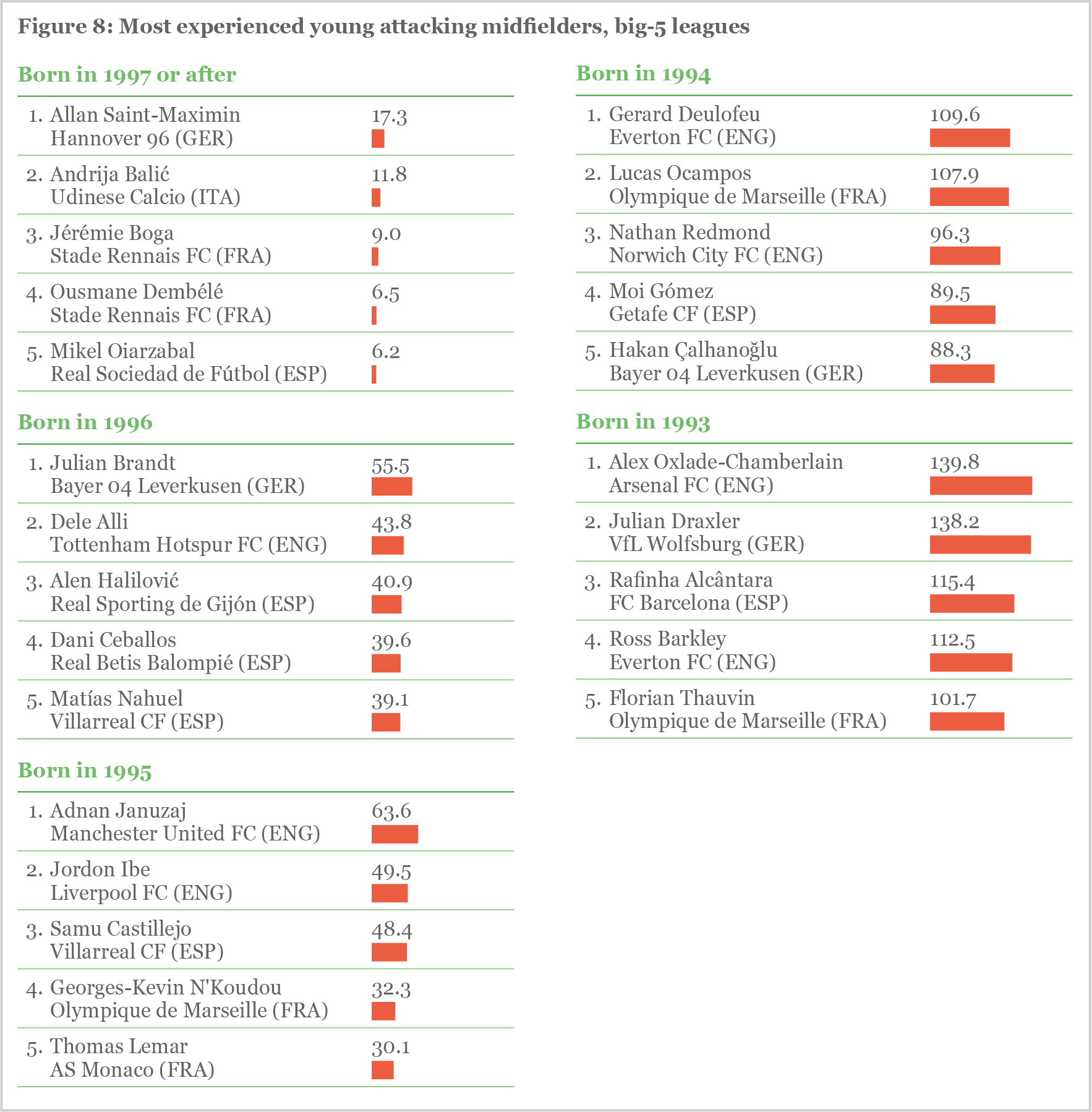
Trained by FC Basle, the Swiss, with Kosovan origins, Albian Ajeti is the most experienced among the U19 forwards. He is ranked ahead of another player whose future looks bright: Borja Mayoral (Real Madrid). His enrollment in the Madrid club, where young players generally see little use, may oblige him seek his fortune elsewhere to pursue his career successfully. The case of Álvaro Morata, trained by Real and transferred to Juventus with a buyback clause, is in this sense exemplary.
At the top of the list for other age groups is the German Timo Werner, as well as three full internationals: Divock Origi, Raheem Sterling and Romelu Lukaku. Other footballers having already played for national A-teams feature in the rankings: Rey Manaj, Kingsley Coman, Leroy Sané, Anthony Martial, Ángel Correa, Memphis Depay, Paco Alcácer, Harry Kane and Mauro Icardi.
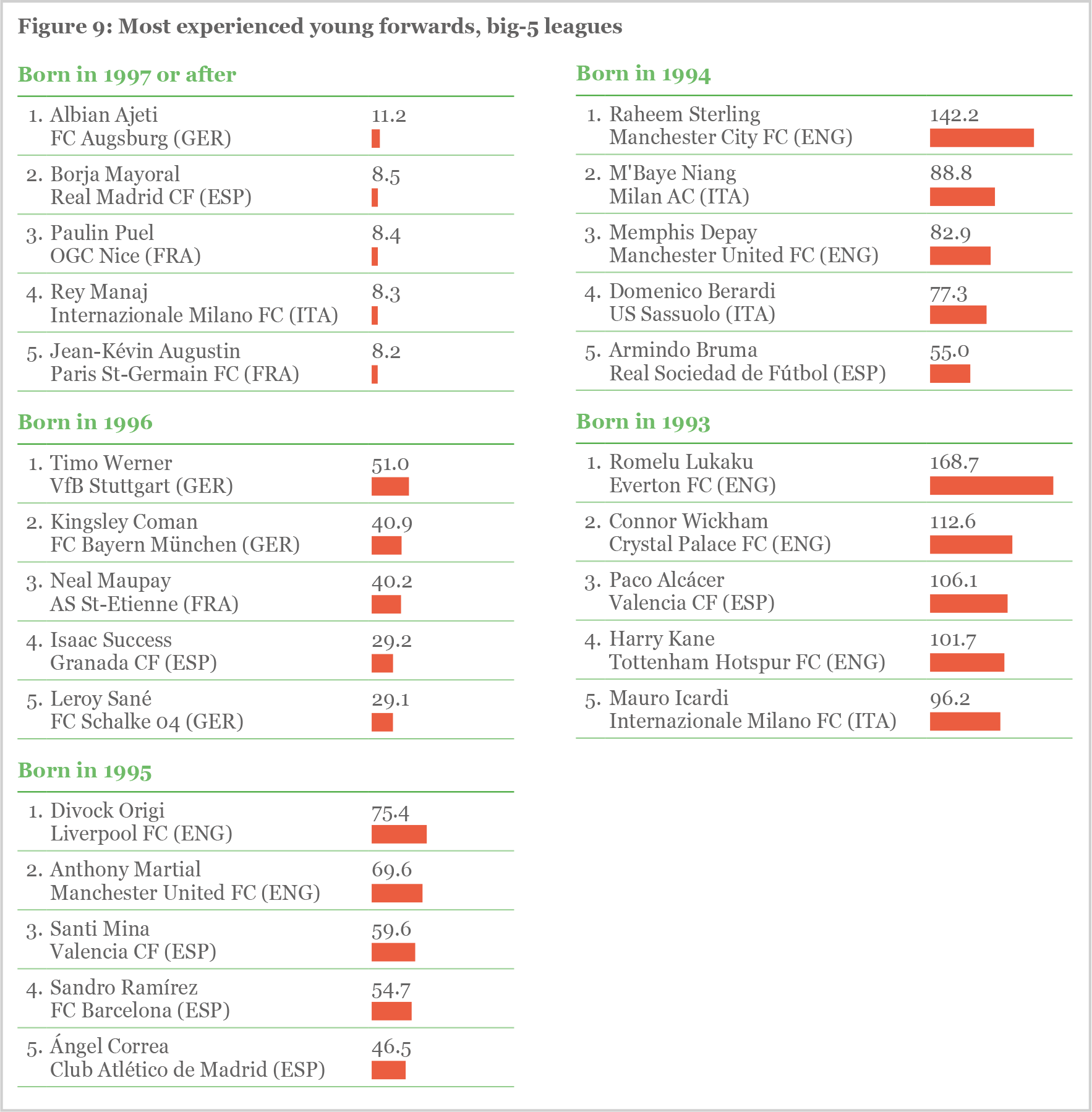
4. Non big-5 league talents
This section presents the U23 footballers playing outside the five major European championships with the highest values in terms of experience capital per position. Among the youngest age groups, we find numerous footballers whose experience accumulated during career is greater than that of most of their contemporaries playing in big-5 league clubs. This situation reflects the difficulty of getting regular games in the most competitive championships at the start of the career.
No big-5 goalkeeper of the same age has as much experience capital as Bartomiej Dragowski and Yvon Mvogo. Dragowski made his debut in the Polish top division in 2014, when he was only 16 years of age. He immediately became the first choice goalkeeper for Jagiellonia Bialystok, the club which trained him and where he has already played over 50 domestic league matches. He has represented the U21 Polish team.
Born in 1994, Mvogo has already played almost 100 official matches with Young Boys, one of the best Swiss clubs. He has also been selected for the Swiss national team despite fierce competition. He is soon likely to be recruited by a big-5 league team. He should however make sure he does not jump the gun. He should take his time to choose a club that will sign him as a first choice. If this is not the case, given the longevity of goalkeepers’ careers, it would be wiser for him to wait a little longer.
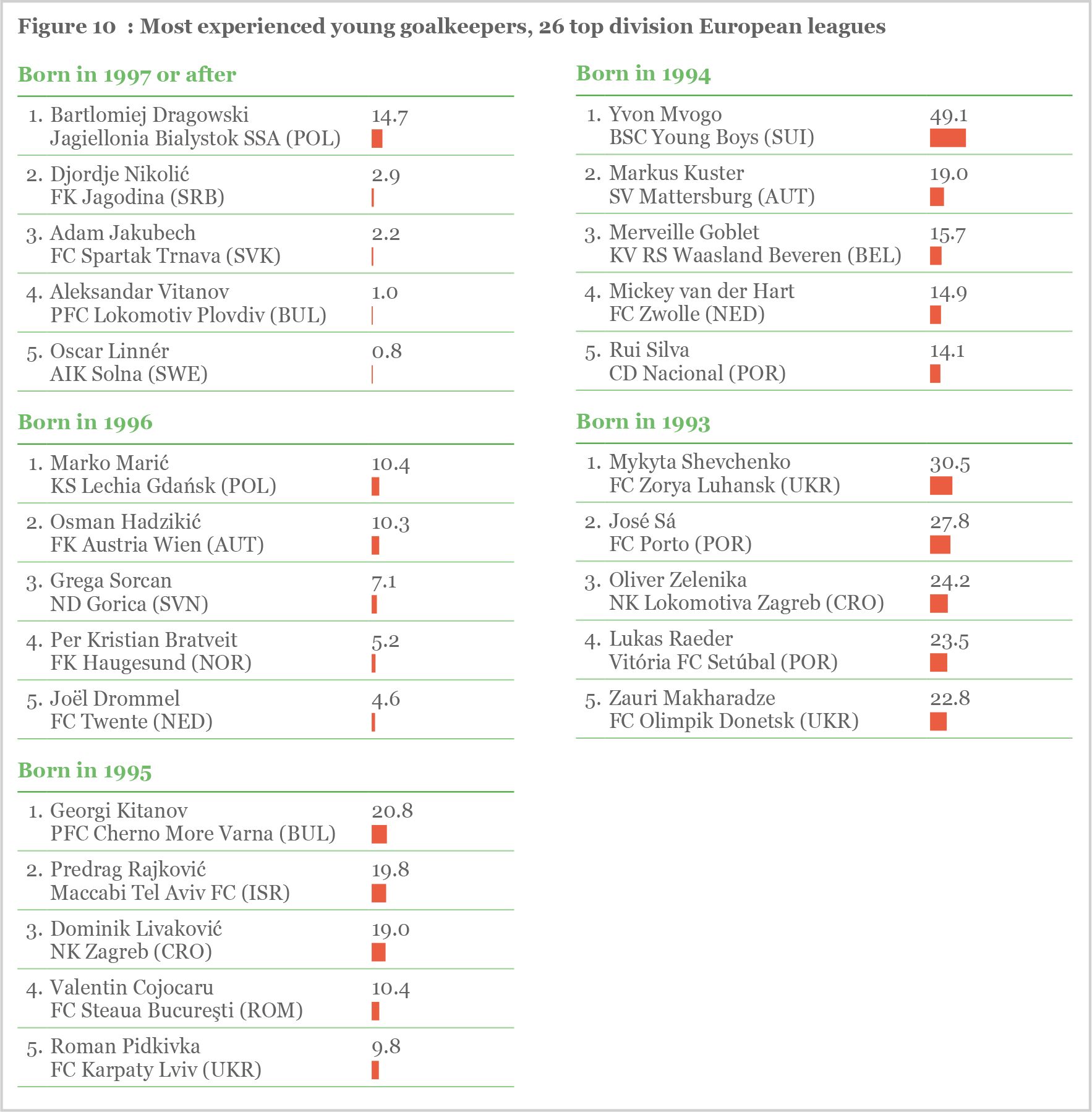
In Europe, no centre back born in 1996 has as much experience capital as Jairo Riedewald. Three days before his 19th birthday, the Ajax player made his debut in the Dutch national A-team. He was 17 years and three months old when he first played in the Eredivisie with Ajax. He came onto the pitch in the 80th minute when his team was being beaten 0-1 at Kerkhade against Roda. Finally, Ajax won 2-1 thanks to two goals scored by Riedewald. It is hard to imagine a better debut.
Leading the rankings of players born in 1995 is Jason Denayer. Trained according to the methods of one of the best experts in the business, the Frenchman Jean-Marc Guillou, Denayer was quickly recruited by Manchester City. The English club first loaned him to Celtic Glasgow and then again to Galatasaray. Time will tell if the Belgian international will be able to successfully establish himself in his home club.
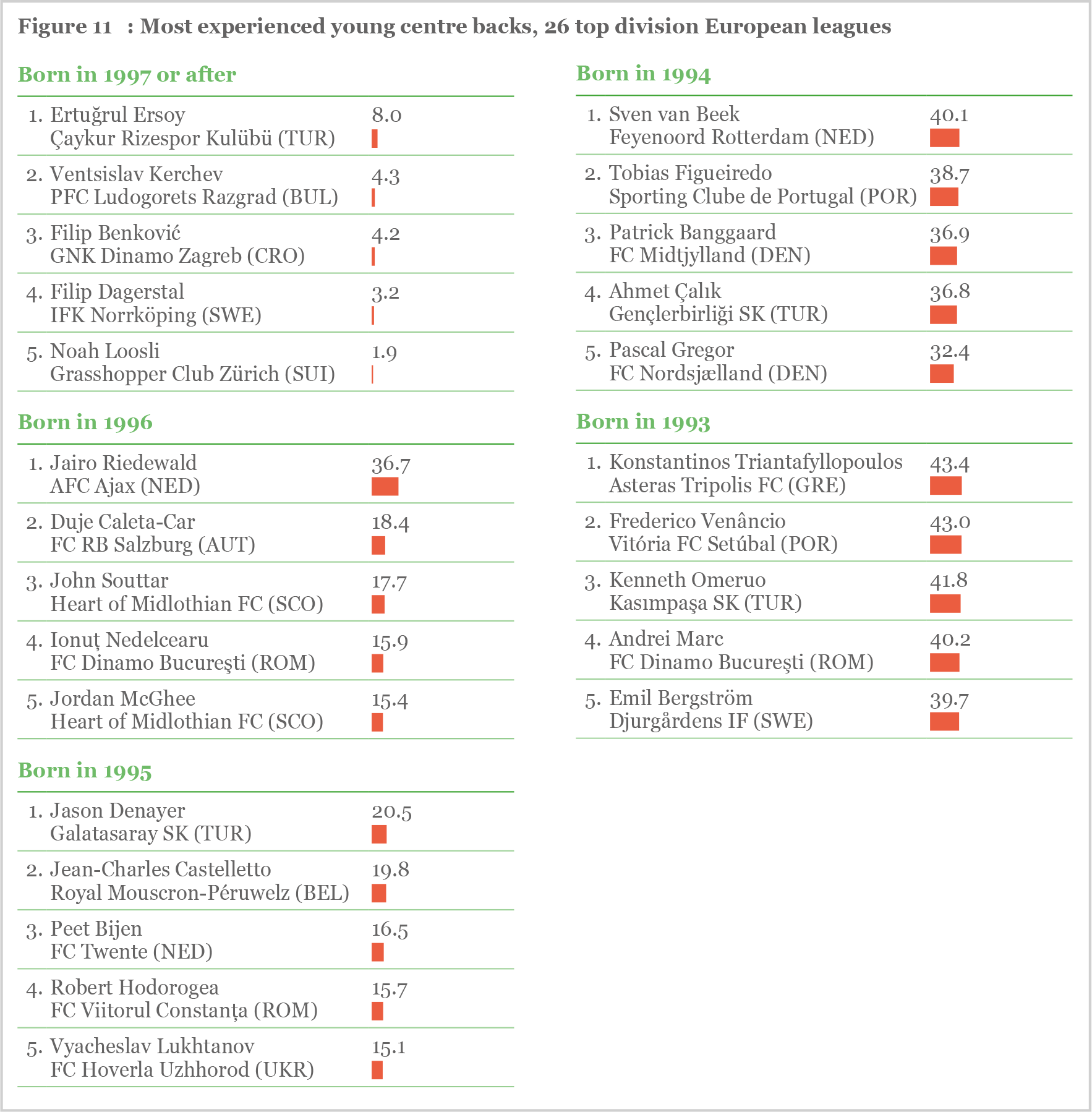
The experience capital of two full backs is greater than that of all their big-5 league contemporaries playing in the same position: Kevin Diks and Linus Wahlqvist. They both were born in the last three months of the year: October for Diks and November for Wahlqvist. This only makes their statistics more impressive (see Monthly Report n°10).
It would not be surprising to see Kevin Diks join Chelsea, a club with which his home team, Vitesse Arnhem, enjoys a privileged relationship. As for Linus Wahlqvist, his quality performances have already been rewarded with two caps for the Swedish national A-team. After Euro 2016, it is a likely bet that he will be transferred to a club participating in a wealthier and more competitive league than the Swedish top division championship.
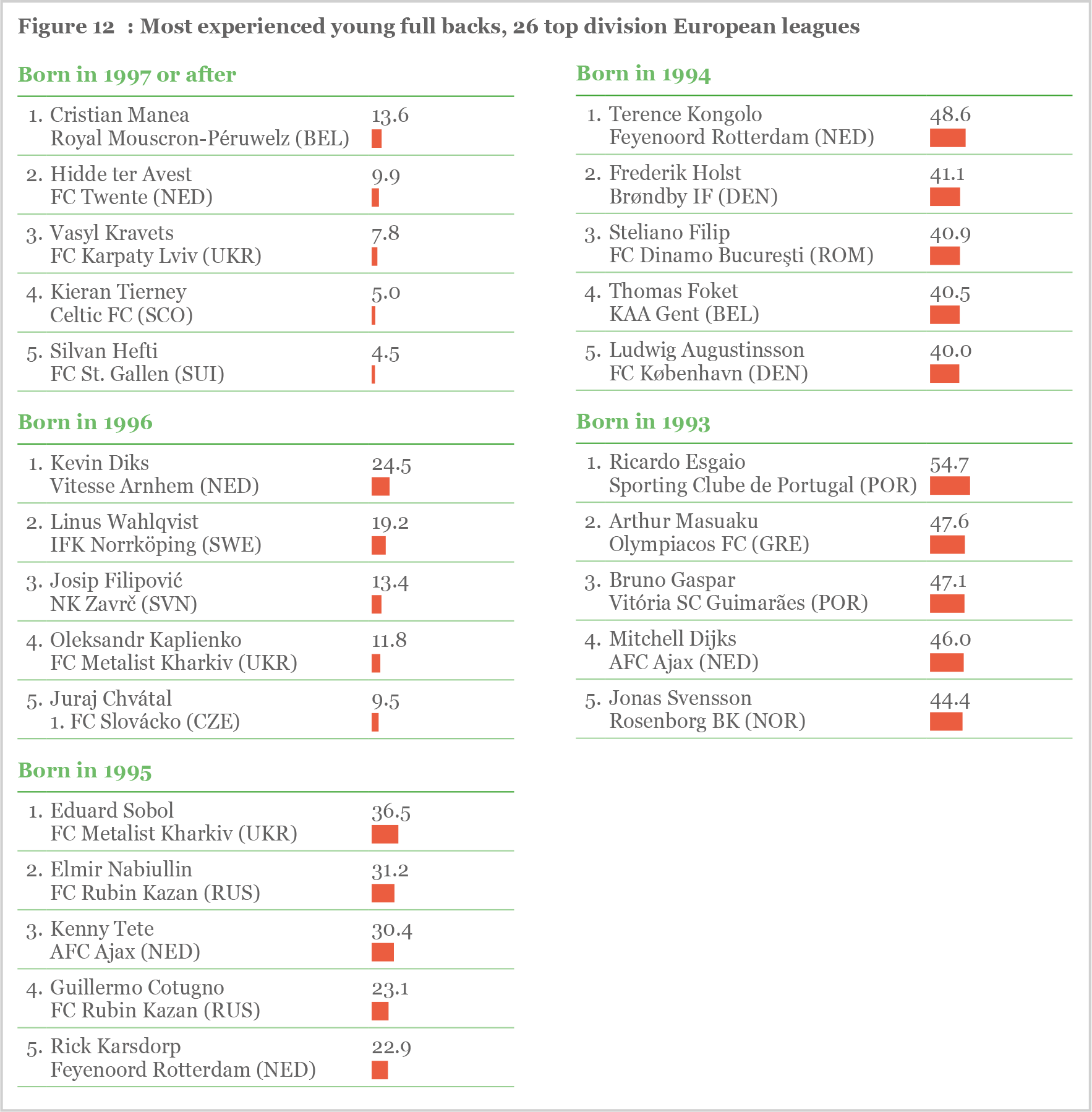
Four players stand out among the central midfielders born in 1997. Their experience capital is greater than any big-5 league footballer of the same position born in the same year: Rúben Neves (Porto), Youri Tielemans (Anderlecht), Renato Sanches (Benfica) and Dragoș Nedelcu (Viitorul Constanța). The level of experience of Neves and Tielemans is particularly impressive: it is even greater than the highest values measured for big-5 league players born in 1996.
The experience capital of Riechedly Bazoer is also superior to any big-5 league central midfielder born in the same year. The Ajax player made his debut in the Dutch national A-team one month after having celebrated his 19th birthday. Another precocious talent to follow closely is Tonny Vilhena. His departure to a big-5 club appears very likely during the 2016 summer transfer window. His contract with Feyenoord runs out next June and clubs interested in his services could recruit him without having to pay a transfer fee.
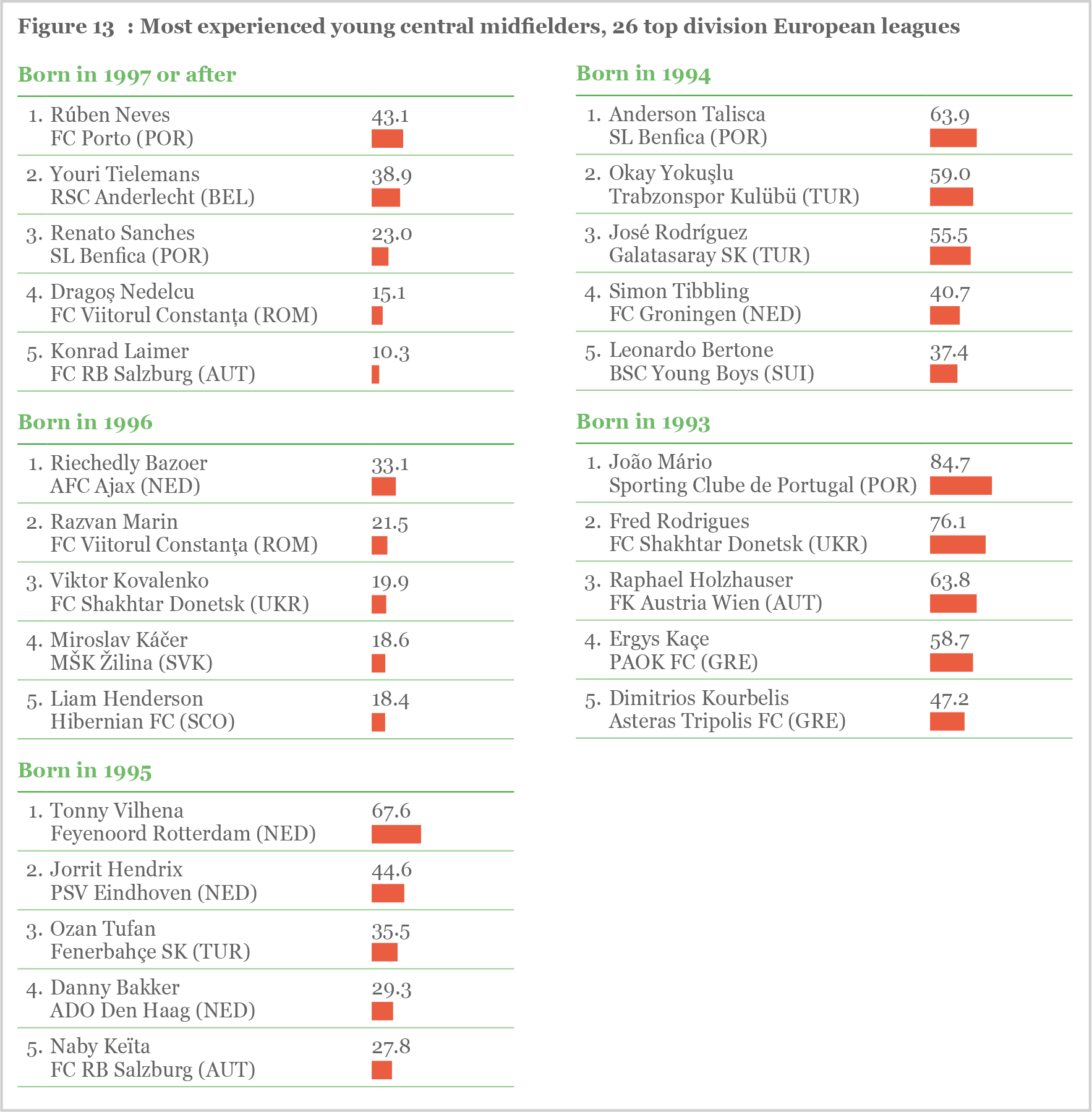
The only attacking midfielder whose experience capital is greater than any other big-5 league player of the same age and position is Ante Ćorić. Aged 19, he has already played more than 50 matches in the best performing Croatian club: Dinamo Zagreb. He also has had a Champions League experience and has already been selected to play for the U21 Croatian side. His compatriot from Hajduk Split, Nikola Vlašić, also has a bright future to look forward to.
The rankings also include other talents who will probably soon be recruited by teams from the five major European leagues. The most experienced attacking midfielder among those born in 1994, Lazar Marković, has already played in the English Premier League. His home club, Liverpool, lent him to Fenerbahçe for the 2015/16 season. Another footballer playing in Turkey, Kerim Frei, has already had the chance to play in the Premier League at the start of his career.
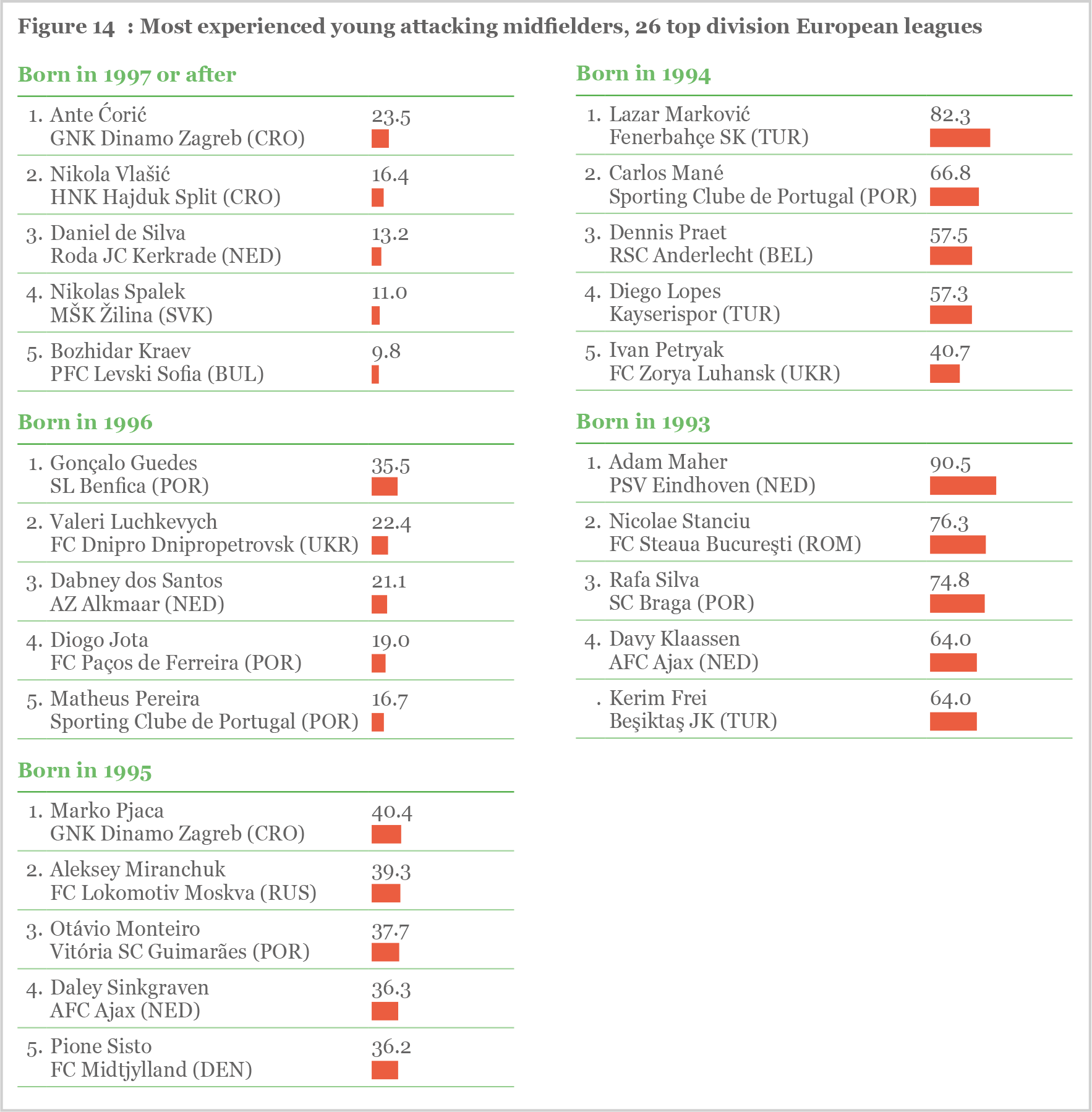
One player stands out clearly from other forwards: Breel Embolo. An undeniable FC Basle first team mainstay, the Swiss with Cameroon origins is also a key player in the Swiss national A-team. His experience capital is greater than all big-5 league forward born in 1997. He would also be ranked fourth among the players born in 1996. He has been on the radar of numerous top level European clubs and his transfer fee will probably be in the tens of millions of euro.
Other players born in 1997 have accumulated more experience than any forward in the five major European championships: Enes Ünal (NAC Breda, on loan from Manchester City), David Kownacki (Lech Poznań), Xande Silva (Vitória Guimarães) and Luka Jović (Benfica). The latter was recruited by the Portuguese side in January 2016 from Red Star of Belgrade. Andrei Ivan (Craiova) and Sander Svendsen (Molde) are also destined for top level careers.
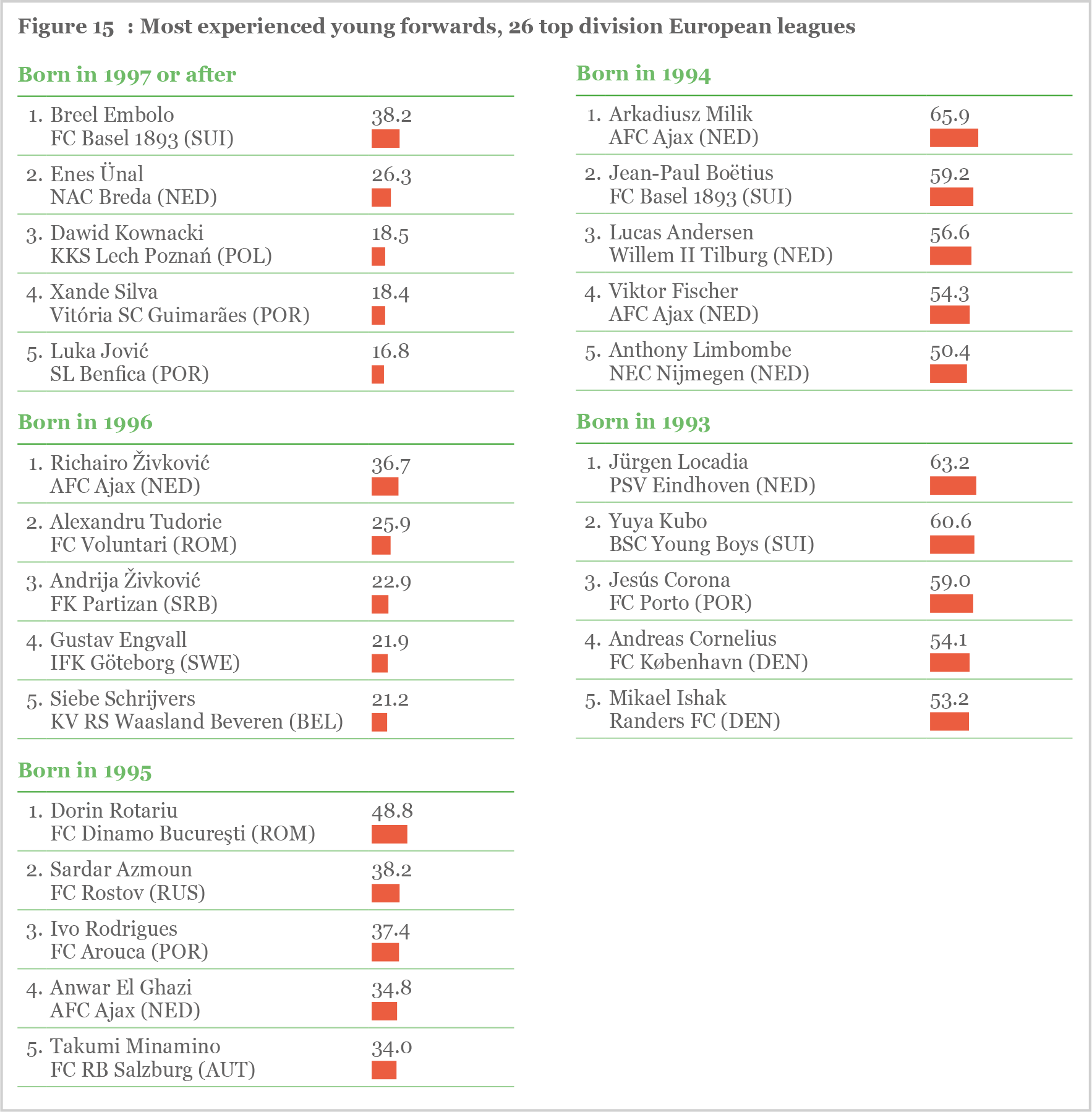
5. Stastistics at the service of recruitment
The experience capital method developed by the CIES Football Observatory research group provides the basis for the setting up of an efficient talent spotting system. With an economy of means, it firstly allows teams covering a large number of countries. Professional clubs can thus hope to outflank the competition even if they do not have a fully-fledged recruitment structure.
Moreover, the approach presented in this study permits the pinpointing of countries where footballers are generally given a sufficient playing time allowing them to fully develop their potential (see also Monthly Report n°13). The success of a career in as competitive an environment as football depends indeed on the context in which the player finds himself as much as his intrinsic talent.
Finally, the method of experience capital allows clubs to optimise their approach regarding transfers by considerably reducing the risks inherent in such operations, from both the sporting and economic point of view. For recruiting clubs, there is indeed no better guarantee than signing footballers who have had the opportunity to play as often as possible at the highest possible level taking into account their age and talent.
Our research team is at the service of clubs interested in finding out more about the practical modalities of implementing a talent spotting system of this kind.
Monthly Report 14 - April 2016 - Spotting future stars